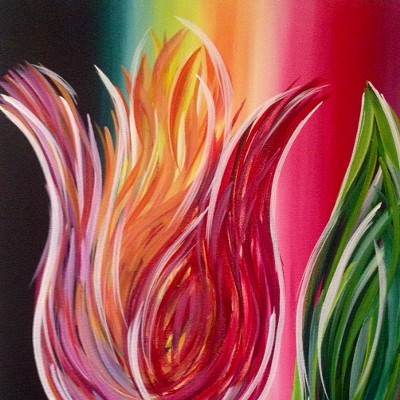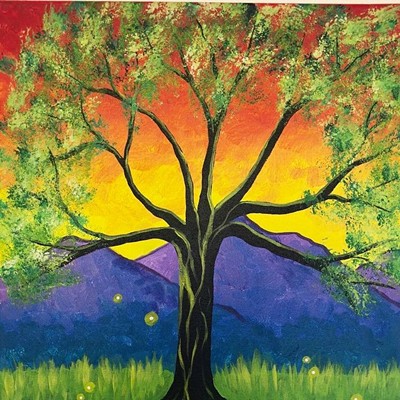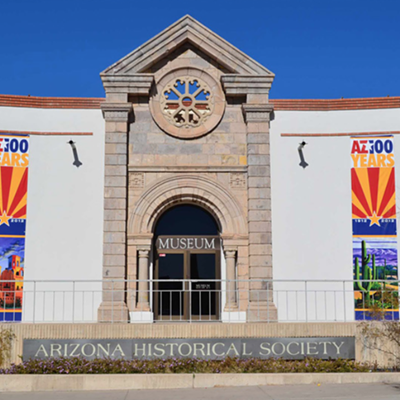Cook's Tucson Paintings picture all the subjects that are staples in local tourist galleries: the majestic Catalinas, the pink charms of the Arizona Inn, the curving Spanish arches at St. Philip's Church, Sabino Creek crashing over rocks. You've seen similar genre paintings so many times your brain barely registers them. Reduced to postage-stamp size on the computer screen, Cook's paintings are nothing but clichés.
But it would be a mistake to confine your viewing to the virtual world's flat glass. In the gallery, Cook's deliciously buttery paint charges outward into a third dimension. Thick swaths of glossy oils--blue against beige, yellow over forest green, rose on maroon--rush across the linen with nary a thought for cowboy cliché. Stand up close, and you can't imagine that these wild brushstrokes are anything but random, the work of an abstractionist in tune with his automatic muse.
When you step back, the pictures coalesce into Pusch Ridge or the barrio's tin roofs or the Arizona Inn's flowers, but that doesn't matter. These are paintings about paint.
"Sycamore Study #2" is ostensibly about an autumnal forest, but it's much more about gorgeous slabs of white, gray and umber (the rocks), brilliant green (the forest floor) and sunlit yellow (the leaves). "Monsoon--Tucson #1" captures the eerie light of a sun shower: The sun turns the trees in the foreground a fluorescent green, while the stormy sky above veers into velvety charcoal. "Catalinas Snow #1" is all delicately shaded pink, white and blue.
Long a successful crossover artist, Cook appeals to art conservatives and iconoclasts alike. He's a modernist in love with his materials, but he paints conventional subjects for people who like their art tame. Thus, the Main Library downtown bought one of his tumbling creek scenes and hung it on its main staircase; it's placid enough to please the realism-loving public, but painted boldly enough to satisfy the paint purist.
The mystery is how Cook manages the conjuring trick, churning out paintings that are abstract and realistic at the same time. Does he plan every swab of rough-and-tumble paint? How can he know that a dash of pale blue against deep blue in the big painting "Catalina" will read as sunlight on rock when he steps away from the linen? Or that the symphony of rich grays in "Monsoon--Tucson #1" will look like rain? Cook's painted marks may seem improvisational, but he evidently follows a score in his head. Still, he paints them quickly. All of the works in this show, numbering more than three dozen, were painted in 2004. They're so fresh you can still smell the paint.
Influenced as he is in technique by the painterly painters from the Impressionists on up, Cook also has drunk up the lessons of the 19th century Western landscape painters. You can see their visions of the sublime in Cook's painted "Catalinas" and "Pusch Ridge." Their exalted mountain peaks, pushing up toward the heavens and divinely lit, have the grandeur of an Albert Bierstadt or a Frank Church, old-time painters awed by the majesty of the American West.
Twelve years ago, Cook won the coveted Stonewall Show, a solo exhibition at the Tucson Museum of Art awarded annually to a regional artist. In the big works in that show, he also painted the awe inspired by great industrial plants, the smelters that shoot fire into the sky and ash into the landscape. And he likes to paint the sea as well, a favorite subject of another 19th-century painter, J.M.W. Turner.
This time around, Cook sticks close to home, painting his favorite local wildernesses. Besides the Catalinas, he's traipsed into Madera Canyon, and he's exhibiting at least five pictures of Sabino Creek. But he's enough of a Tucsonan to be as charmed by the city's Mexican rituals and vernacular architecture as he is by the landscape. Día de los Muertos inspired a couple of grave paintings, their flower-strewn white crosses rising up out of the ground. Each one is also a color study; the cemetery dirt of "All Saints #2" gives Cook a chance to go wild with daylight ochre and tan. It becomes night-time mud and deep blue in the candle-lit "All Saints #3." The barrio paintings are fine tangles of diagonal tin roofs, looping telephone wires and soft-edge adobes, nestled in the shadow of Sentinel Peak.
By comparison with the barrio paintings' lively disorder, Cook's Arizona Inn pictures are a little too prim. He seems to have been inhibited by the elegant old hotel's controlled environment, its carefully planned gardens and meticulously painted pink buildings. The place doesn't lend itself to much creative interpretation, and these paintings look a bit like corporate commissions.
He has had a little fun with the pool gate, gouging out the thick paint of the background to make the vertical wrought-iron bars. And the flower gardens yielded up some nice color explosions, paintings without horizon that are pure posy--and pure paint--from top to bottom.














